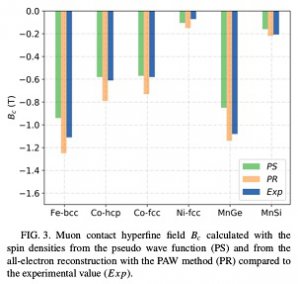Italy: Atomistic modelling for Data Treatment
Data analysis from Muon Spin Rotation and Relaxation Spectroscopy (µSR) has been signifcantly advanced by atomistic modelling, such as DFT methods that predict the location of a muon after implantation. But what if we could also predict hyperfine interactions that describe how a muon couples magnetically with its surrounding electrons? This is particularly relevant in magnetic materials.
A crucial point if DFT methods are to provide this information, is to assess the accuracy and reliability of the computational predictions. Ifeanyi John Onuorah, Pietro Bonfà and Roberto De Renzi, from the University of Parma in Italy, took on this project as part of SINE2020 Work Package 10: Data Treatment.
They chose three magnetic metals – Iron (Fe), Cobalt (Co) and Nickel (Ni) – and two chiral magnets – MnSi and MnGe – that had existing experimental results for the hyperfine interactions. These interactions are generally difficult to obtain experimentally, making the possibility of replacing measurements with compuational methods even more valuable.
The researchers then performed DFT calculations on these same materials, first by calcualating the parameters of the pristine material, then by calculating how much a muon distorted the lattice and influenced the electronic and magnetic properties of that material. The computational and experimental results were then compared.
Agreement between the two set of results was good and results indicated that disruption of the lattice only affected the muon’s nearest neighbours and that distortions were shortranged and small.
Luckily, muons usually form bonds with the most electronegative atoms in the materials which do not usually contribute much to the magnetic properties. In metals, positive muons are usually screened by the electron cloud present. These effects mean that any disruptions are usually confined to short distances from the muon and do not affect the overall magnetic structure of the material.
The work has been published in Physical Review B (I. J. Onuorah, P. Bonfà, and R. De Renzi, Phys. Rev. B 97, 174414 (2018)) concluding that DFT methods are able to fairly accurately predict the experimental result in metals as illustrated below in Fig. 3, from the paper.

These new computational methods can be integrated into MuESR – Magnetic Structure and Muon Embedding Site Refinement – a computer program that can be used to evaluate the local field at the muon sites. MuESR is opensource, documented and available within GPLv3 . Download information can be found on our Software page.
In relation to this study, Ifeanyi John Onuorah also provided training in muon DFT techniques to muon scientists at PSI (Switzerland) and some Ph.D. students.
Acknowledgements: Roberto De Renzi, UNIPR and Thomas Holm Rod, ESS
References:
P. Bonfà, I.J. Onuorah, R. De Renzi, Introduction and a quick look at MUESR, the Magnetic structure and mUon Embedding Site Refinement suite, JPS Conf. Proc. 21, 011052
J. Onuorah, P. Bonfà, and R. De Renzi, Muon contact hyperfine field in metals: A DFT calculation, Phys. Rev. B 97, 174414 (2018).
Back to The Road to the ESS
Other articles: Unviersity of Parma, muonSR, Data Treatment, Computational Modelling




